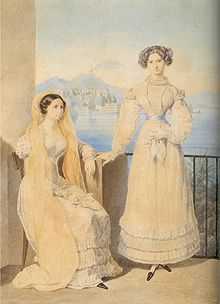Dorothea de Ficquelmont

Dorothea "Dolly" de Ficquelmont (14 October 1804, Saint Petersburg, Russian Empire – 10 April 1863, Venice, Austrian Empire), born Countess Dorothea von Tiesenhausen (Daria Fyodorovna in Russian), was a Russian writer and salonist. A granddaughter of the Russian war hero General Prince Kutuzov (who distinguished himself in the Napoleonic Wars), she was a Russian aristocrat of German Baltic origin, and later a member of the Austrian nobility as the wife of Count Karl Ludwig von Ficquelmont.
Biography

Dolly von Tiesenhausen was the daughter of Count Ferdinand von Tiesenhausen, aide-de-camp of Emperor Alexandre I of Russia who died at Austerlitz,[1] and of Princess Elisabeth "Lisa" (sometimes "Elisa") Koutouzova, daughter of Prince Kutuzov. Her mother remarried in 1811 to Count Nicolas Khitrovo, Russian special envoy to the Grand Duchy of Tuscany. From 1815, Dolly von Tiesenhausen spent her childhood with her mother and her sister Catherine — future lady-in-waiting of the Imperial Court of Russia — in Reval, then moved to Florence where she spent the rest of her youth.
On 3 June 1821 she married Count Charles-Louis de Ficquelmont, Austrian Ambassador before the Habsbourgs-Tuscany, who was 27 years her senior. Following their marriage, the Count was appointed Ambassador to the Court of King Ferdinand I of Two Sicilies in Naples. In spite of the revolutionary troubles in the Kingdom of Two Sicilies and the increasing tensions between Austria and Naples, the Ficquelmonts perfectly integrated into Naples' aristocratic high society.
In 1823, the Ficquelmonts travelled to Saint Petersburg. Emperor Alexander offered her mother, Princess Khitrova, an imperial pension and the family was often seen at Court.
A large correspondence between the Khitrovos and the Emperor shows that he had befriended the Ficquelmonts.
Back in Naples in 1825, Dolly gave birth to her only daughter, Elisabeth-Alexandrine-Marie-Theresa de Ficquelmont, Countess de Ficquelmont by birth and Princess Clary und Aldringen by marriage.
In 1829, Dolly's husband was appointed Austrian Ambassador in Russia. The couple bought a palace at 4 Palace Quay which hosted their household and was used as an Austrian Embassy. Dolly's mother, Elisabeth Khitrovo had her own apartments in the palace and held a salon. Countess Ficquelmont, who took great interest in literature, philosophy, religion and politics, also held her own salon.[2] Alexander Turgenev, Viazemski or Ivan Kozlov were regulars of the countess's salon. Pushkin was often seen in Ficquelmont's salon which was described by Prince Wiazemsky as "a place of wisdom and intelligence".[3]
In 1839 her husband was recalled to Vienna to assume the duties of the Foreign Office, so the Ficquelmonts left Russia. During her remaining years, Dolly essentially lived between their palaces of Vienna and Venice and their daughter's castle in Teplitz.
Her husband, Count de Ficquelmont became Minister-President of the Empire during the 1848's revolutionary troubles. But, close ally of Russia, he was accused of supporting the Russian repression. The Countess, who was at their Venice's Palace at the time,[4] was arrested twice by the Venetian guarda civil and finally had to leave the city on board an English ship with her daughter, son-in-law and grandchildren.
The family eventually returned to Venice after the Revolution ended and Count de Ficquelmont died in their Venetian Palace in 1857.
After her husband's death, Dolly continued writing her correspondence and organized it in order to publish it. It is mostly made up of philosophy and political thoughts. She also wrote a Journal (Diary) in French that was published in 1950 in Italian and Russian. The St.Petersburg's period had been closely studied by historian Antony Florovski (1884–1968).
Countess Dolly de Ficquelmont is buried in Princess Clary und Aldringen's family chapel in Dubi, near Teplitz.
Relationship with Pushkin
Countess de Ficquelmont met Pushkin during fall 1829 and often invited him to her Saint Petersburg Palace. They became friends. In 1922 historian Mstislav Tsiavlovski published the writings of poet Nachtchokine (Pushkin's friend): according to Barteniev, Pushkin was in love with a brilliant socialite noblewoman holding a salon in Saint Petersburg. Even if the lady is not named, no doubt she is Countess de Ficquelmont. Ficquelmont's palace is also believed to be the frame for the old Countess' palace in Pushkin's story The Queen of Spades. Pushkin would also have depicted his own feelings for Dolly through Hermann's love for Lise. However, historian Leonid Grossman has said Pushkin only saw himself as a new Boccaccio. Indeed, the relationship between Countess de Ficquelmont and her husband was perfect.
See also
- Family von Tiesenhausen
- Family de Ficquelmont
Notes
- ↑ His death inspired the André Bolkonski episode in Tolstoï's War and Peace
- ↑ (The St.Petersburg's Ficquelmont Palace) provided the setting of two of the most famous salon of the period (1830s), reigned over by Ficquelmont's wife (grand-daughter of Prince Kutuzov) in Personality and Place in Russian Culture, Essays in Memory of Lindsey Hughes, Simon Dixon, 2010, History
- ↑ In the early 1820s the Countess read in the original language Sallust, Cicero, Virgile, Terence, Dante, Petrarch, Manzoni, Goethe, Byron, Schiller, Jean Paul, Hofmann, Milton, Fénelon, La Rochefoucauld, Madame de Genlis, Chateaubriand, Madame de Staël, Lamartine, Victor Hugo, Benjamin Constant, Lamennais, Montalembert, etc. according to N. Kauokhtchichvili who helped with the first publication of her Journal (Diary) in Russian.
- ↑ Venetia was a part of the Austrian Empire
Sources
| Wikimedia Commons has media related to Dorothea de Ficquelmont. |
- Фикельмон, Дарья Федоровна
- М. И. Гиллельсон. Пушкин в итальянском издании дневника Д. Ф. Фикельмон
|
